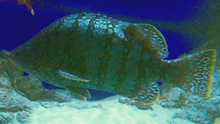Smooth grouper
| Smooth grouper | |
|---|---|

| |
| Scientific classification | |
| Domain: | Eukaryota |
| Kingdom: | Animalia |
| Phylum: | Chordata |
| Class: | Actinopterygii |
| Order: | Perciformes |
| Family: | Serranidae |
| Subfamily: | Epinephelinae |
| Genus: | Dermatolepis |
| Species: | D. striolata
|
| Binomial name | |
| Dermatolepis striolata (Playfair,1867)
| |
| Synonyms[2] | |
| |
Thesmooth grouper(Dermatolepis striolata) is a species of marineray-finned fish,agrouperfrom thesubfamilyEpinephelinaewhich is part of thefamilySerranidae,which also includes theanthiasand sea basses. It is associated with reefs and is found in the western Indian Ocean.
Description
[edit]The smooth grouper has a body which is at 2.4-2.6 times as deep as itsstandard length[3]The eye has a diameter which is markedly shorter than the length of the snout. The preopercle is serrated with the serrations covered by skin. The spines on the gill cover are not easy to see. The dorsal profile of the head is slightly concave or straight. The caudal fin is rounded or truncate with rounded corners. It has smooth scales which are largely covered by skin and auxiliary scales. There are 11 spines and 18-19 soft rays in thedorsal finwhile theanal finhas 3 spines and 9-10 soft rays.[2]The colour of this fish is overall yellowish to reddish brown, becoming paler ventrally. The adults have small, round, dark spots covering the head, body and fins. The juveniles have many small dark brown spots on the head, body and fins, the spots on the body are elongated horizontally while those on the fins are less obvious. The dorsal, anal and caudal fin also have pale spots and there are also pale, irregular blotches of various sizes which vary on visibility too.[3]This species attains a maximumtotal lengthof 85 centimetres (33 in) and the maximum published weight is 10.5 kilograms (23 lb).[2]
Distribution
[edit]The smooth grouper is found in the western Indian Ocean. Along the African coast its distribution extends from Somalia toDurbanin South Africa. It is also found around theComoros Islands,Madagascar andAldabrain the Seychelles. It is also found around the southernArabian Peninsulaas far east as the Iranian waters of theGulf of Oman.It has also been reported from theRed Sea.[1]
Habitat and biology
[edit]The smooth grouper is a rare species found on the shallow waters of sheltered, turbid coastal rocky or coral reefs. They have been reported to shoal in small in small groups of up to 8 fishes. Analysis of stomach contents show that they arepiscivorus.[2]It is not known whether they form aggregations forspawning.[1]
Taxonomy
[edit]The smooth grouper was first formallydescribedasSerranus striolatusin 1867 by theScottishsoldier,diplomat,naturalistand authorLambert Playfair(1828-1899) with thetype localitygiven asZanzibar.[4]
References
[edit]- ^abcBarreiros, J. (2018)."Dermatolepis striolata".IUCN Red List of Threatened Species.2018:e.T44672A100459401.doi:10.2305/IUCN.UK.2018-2.RLTS.T44672A100459401.en.Retrieved15 November2021.
- ^abcdFroese, Rainer;Pauly, Daniel (eds.)."Dermatolepis striolata".FishBase.December 2019 version.
- ^abHeemstra, P.C. & J.E. Randall (1993).FAO Species Catalogue. Vol. 16. Groupers of the world (family Serranidae, subfamily Epinephelinae). An annotated and illustrated catalogue of the grouper, rockcod, hind, coral grouper and lyretail species known to date(PDF).FAO Fish. Synopsis. Vol. 125. FAO, Rome. p. 68.ISBN92-5-103125-8.
- ^Eschmeyer, William N.;Fricke, Ron & van der Laan, Richard (eds.)."Serranus striolatus".Catalog of Fishes.California Academy of Sciences.Retrieved22 June2020.

